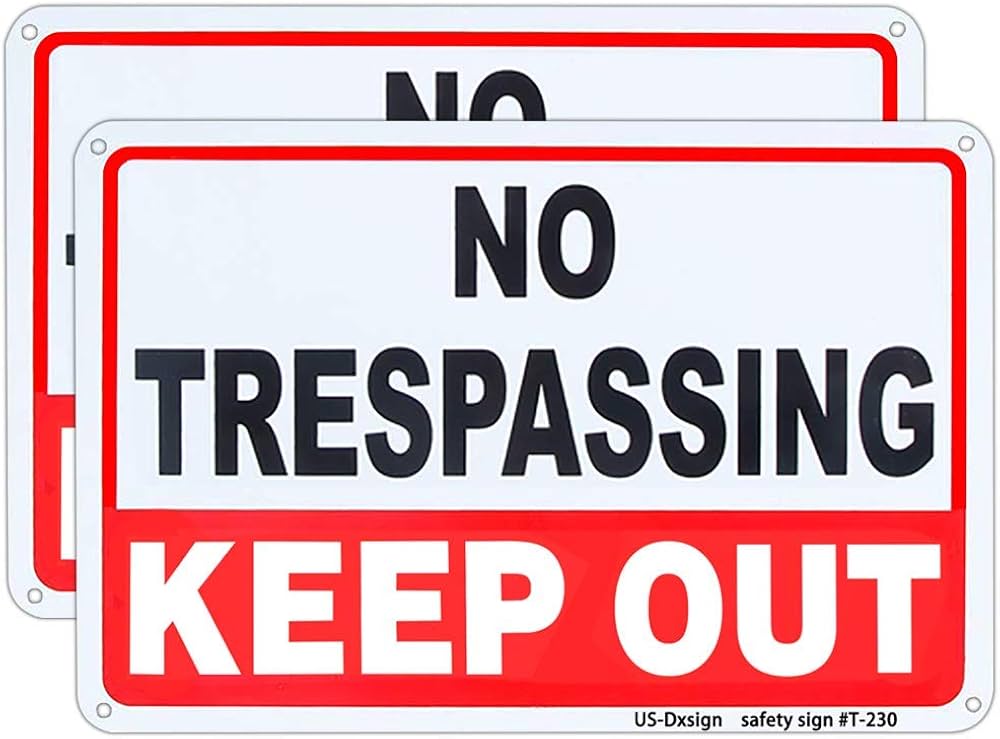
No trespassing signs are a crucial element in safeguarding your property and ensuring the safety of both yourself and others. These signs act as a clear and unambiguous declaration that certain areas are off-limits to the public, effectively deterring unauthorized entry and potential trespassers. Understanding the significance of these signs and how to utilize them properly can significantly contribute to protecting your rights and minimizing risks associated with unwanted access.
This article will delve into the multifaceted importance of no trespassing signs, exploring their legal implications, safety benefits, various types available, and best practices for placement and visibility. By gaining a comprehensive understanding of these aspects, you can effectively leverage no trespassing signs to create a secure and controlled environment on your property.
Importance of No Trespassing Signs
No trespassing signs serve several vital purposes, extending beyond simply marking boundaries. They act as a primary deterrent against unauthorized entry, discouraging individuals from crossing onto private land without permission. This proactive measure helps prevent potential damage to property, theft, vandalism, or even more serious incidents involving trespassers.
Furthermore, these signs establish clear expectations and communicate your ownership rights to the public. By prominently displaying no trespassing signs, you are making it abundantly clear that certain areas are off-limits and that any unauthorized entry will be considered a violation of your property rights. This serves as a legal safeguard, providing evidence of your intent to restrict access and potentially aiding in legal proceedings if necessary.
Legal Protection & Property Rights

No trespassing signs play a crucial role in upholding your legal rights as a property owner. They serve as formal notice to the public, clearly defining the boundaries of your property and prohibiting unauthorized entry. By posting these signs, you are asserting your ownership rights and establishing a legal framework for addressing trespassers who disregard your boundaries.
It’s important to note that while no trespassing signs act as a deterrent and provide legal standing, they do not automatically grant immunity from liability in all situations. Local laws and regulations may vary regarding the specific requirements for signage and enforcement. Consulting with a legal professional can help ensure you are fully compliant with applicable laws and understand your rights and responsibilities as a property owner.
Safety & Liability Reduction
No trespassing signs contribute significantly to enhancing safety on your property by minimizing potential risks associated with unauthorized access. By restricting entry to designated areas, you can control who has access to potentially hazardous locations, such as construction sites, chemical storage facilities, or private residences. This helps prevent accidents, injuries, and liability claims arising from individuals entering restricted zones without proper authorization.
Furthermore, no trespassing signs can deter criminal activity by discouraging potential intruders from targeting your property. The visible presence of these signs serves as a warning to trespassers, making it less likely that they will attempt to enter your property for illegal purposes. This proactive measure helps create a safer environment for yourself, your family, and any visitors to your property.
Types of No Trespassing Signs

No trespassing signs come in various designs, materials, and sizes to suit different needs and preferences. Some common types include:
- Standard Rectangular Signs: These are the most common type, featuring bold lettering and clear graphics indicating “No Trespassing.” They are typically made from durable materials like aluminum or plastic and can be easily mounted on posts or fences.
Warning Signs with Symbols: These signs incorporate additional symbols, such as a skull and crossbones or a barbed wire fence, to emphasize the seriousness of trespassing and potential hazards.
Customizable Signs: You can also opt for personalized signs that include your property name, address, or specific instructions regarding restricted areas. This adds an extra layer of clarity and reinforces your ownership rights.
Placement & Visibility
The effectiveness of no trespassing signs hinges on their proper placement and visibility. Consider the following factors when determining the optimal location:
- Boundary Lines: Place signs along property lines to clearly mark the perimeter of your land. Ensure they are visible from both sides of the boundary, especially at points where access is common or potential trespassers might attempt entry.
High-Traffic Areas: Strategically position signs in areas with high foot traffic or vehicle movement, such as entrances, driveways, and pathways leading to restricted zones.
Clear Line of Sight: Avoid placing signs behind trees, bushes, or other obstructions that could hinder visibility. Ensure they are positioned at a height that is easily seen by pedestrians and drivers.
Conclusion
No trespassing signs are an essential tool for protecting your property, ensuring safety, and upholding your legal rights as a property owner. By understanding their importance, implementing best practices for placement and visibility, and staying informed about local regulations, you can effectively utilize these signs to create a secure and controlled environment on your land. Remember, clear communication and proactive measures are key to deterring unauthorized entry and minimizing potential risks associated with trespassing.
